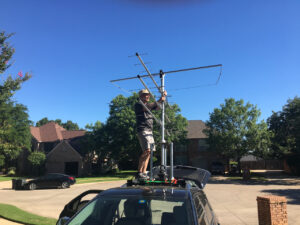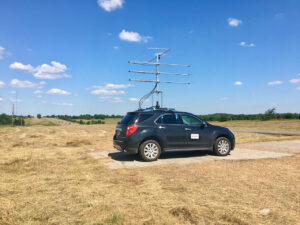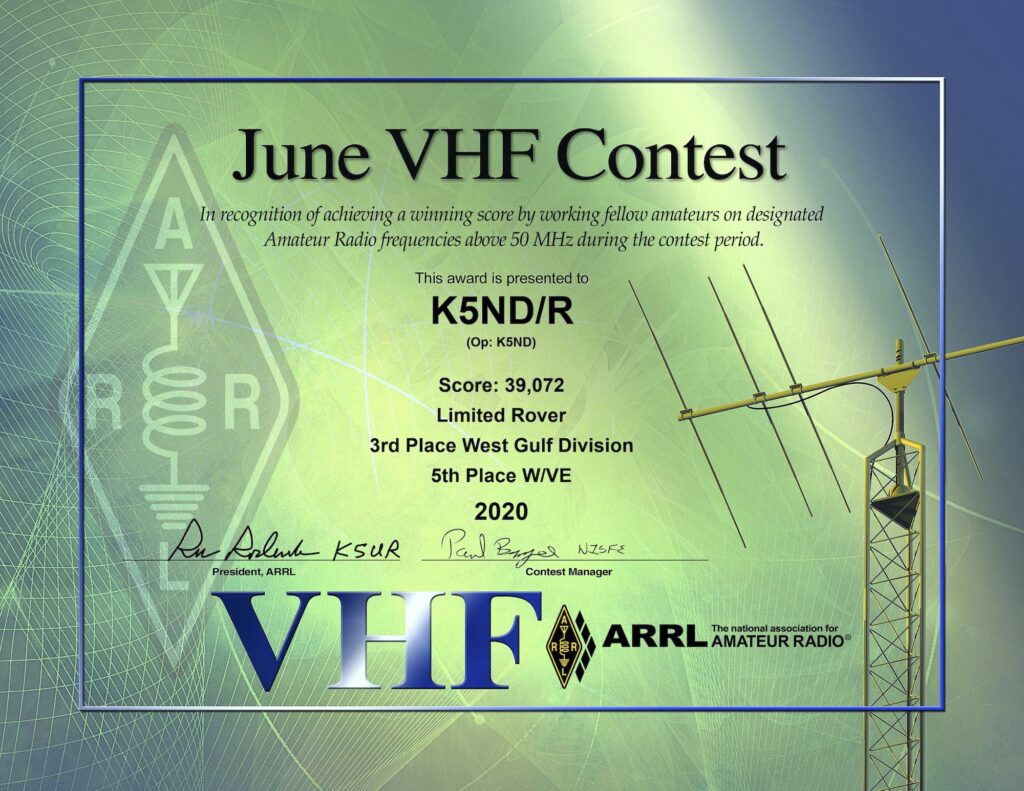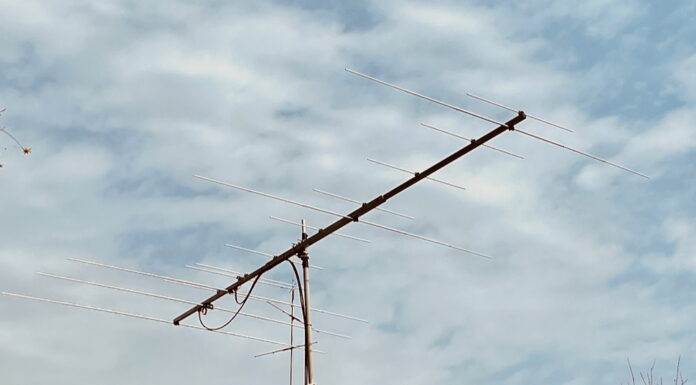Rover Results
My raw score came in at 40,736 with 282 QSOs, 124 multipliers, and 10 grids activated. Here’s the break down:
- 50 MHz — 234 QSOS
- 144 MHz — 26
- 222 MHz — 10
- 432 MHz — 12
Of those QSOs there were 261 FT8 and 21 SSB. No CW and I didn’t look for FM signals.
Most of the time I was operating FT8 on both 50 and 144 at the same time. I did go to SSB for some schedules. At the end of the contest, when six meters really opened up, I was in EM14 and worked lots of stations. For the first hour I worked 28 QSOs and second hour ran 33 QSOs. And for a 10 minute spell ran 9 QSOs. This is pretty good for FT8, but I should have picked up the microphone and worked more stations.
Surprise of the Contest — EA8RH in Tenerife answering my CQ TEST from EM21. Alas, didn’t complete the QSO.
Rover Rigs

For this contest I brought back my IC-9100 and IC-910H. The IC-9100 ran about 10 watts into a TE Systems 170 watt 6 meter amplifier and a Q5 Signal DEMI 222 MHz transverter with 25 watts out. The IC-910H ran barefoot on 144 and 432.
In the January 2020 VHF contest, I had Icom loaner IC-7300 and IC-9700 rigs with RFI issues — which I solved with lots of ferrite after the contest. No problems this time with RFI, perhaps because I used Digimode interfaces between both rigs rather than USB interfaces. The Digimode uses an opto-isolator on PTT and transformers on the audio link.
Rover Antennas

My roof top rotator mount holds Directive Systems Rover Yagis for 144, 222, and 432. For six I use a Par Electronics Stressed Moxon. They all worked great with no encounters with trees during the contest this time. Although there was a twist of the moxon in the wind as I drove from EM13 to EM02. And, of course, one encounter with a tree during set up a few days before the contest. Bent it back in shape and all was well.
Rover Software
Kudos to N1MM with the follow-up analysis tools and sound logging of contacts. I just wish it were easier to move between WSJT-X and SSB. This required shutting down WSJT-X to make a SSB QSO followed by sometime snags reengaging WSJT-X.
After the contest I had to enter the Rover QTH grid for every WSJT-X contact as it wasn’t recorded even though I updated the grid at every stop — both in N1MM and WSJT. I’ve submitted a feature request to N1MM. Hopefully, it will be an easy improvement. [N1MM was corrected for the next update — very fast response.]
I will note, too, that N1MM doesn’t provide rover scoring for the number of grids activated. I needed to calculate that separately before submitting my log. Still it worked quite well, with the usual number of arduous tasks always expected of a rover. Here’s my earlier review of N1MM for VHF Contesting.
Next are uploads of QSOs for each grid activated into Logbook of the World under the call sign K5ND/R.
FT8 — Worked Great. Even so, as noted above, I should have picked up the microphone when the band really opened up at the end of the contest. In addition, what I believe were JTDX users were somewhat troubling. It would seem that when they answer “CQ TEST” they would expect a contest mode exchange. At least with current versions of WSJT-X whether you’re in contest mode or not, the software figures it out and moves ahead with the QSO. Not so JTDX and their operators.
I had one station that bounced back and forth with me for at least six or maybe eight exchanges not moving from my R report. I finally stopped and went to SSB for a few 222 skeds. When I came back I encountered the same issue with another station and finally resolved to switch out of contest mode to make the QSO. Then, of course, I forgot to switch back for a few QSOs. Gee whiz.
Monitoring Slack-VHF-Chat, Twitter, and text messages proved a bit challenging for me. I responded to one query that my multi-tasking was lame, which pretty much sums it up.
The messages reached a crescendo when I got near EM24 — when will you get there, point toward me, tell me your sequence and frequency offset. It’s nice to try and help people work a new grid. But for me at least, hearing the station is the only real proof that you can actually make the QSO. Although I did work a few 144, 222, and 432 QSOs with text messages for alerts to the stations that needed grids.
Perhaps there’s a place here for those live video feeds from the ham station — this would be over the shoulder of the rover. On second thought, that might prove illegal for a contest. I did try APRS for this contest but used my iPad for beaconing. It always went to sleep between grids and only beaconed when I remembered to activate it.
I used my cell phone hotspot to link the laptop and iPad to the Internet. However, I ran into a snag early on Sunday when the laptop first refused to find the hotspot. Later it started working but lost it about mid-way through the day. I use Meinberg-NTP to time sync, monitor DX Maps, and use VHF-Chat Slack. The iPad picked up some of these tasks. Perhaps I need to explore a USB Dongle for GPS time sync for the future.
Rover Route — Social Distancing
Talk about Butt in Chair/Seat — 14 hours operating and 18 hours driving, including my drive to the starting grid, driving home Saturday evening, back to the route on Sunday morning, and finally driving home after the contest. All this came to 760 miles on the road and about five hours sleep Saturday night.
Normally, if “normally” fits a rover, I would stay in a hotel overnight, which would save a couple of those hours. But I was under “social distancing” protocol, which even excluded stopping for food. Amazingly I made only two stops for gasoline. I had thought about risking a drive-through meal, but my rover antennas prohibited entry.

Overall the route worked well. I only wish that the 6 meter band would have been open while I was in EM24 which is a somewhat more sought after grid than EM14, where the band really opened up.
I had planned 11 grids but skipped EM12 on Sunday morning and went to EM21. I was a bit crunched for time and EM12 is my home grid, which didn’t offer any magic. The rest of the grids generated at least a bit of interest — as well as lots of interest in EM24 and EM14.
Higher Local Activity
I did notice that there was a great deal more activity locally, particularly on Saturday. I’m reasonably sure this is because the HamCom hamfest, which always happens the same weekend as the VHF Contest, was cancelled this year. I sure hope a few operators will catch the bug — the VHF contesting type of bug.
Rover Video
I also generated a video that includes set up of the full rover configuration along with snapshots of each of the ten grid stops. It’s only three minutes at VHF Rover Rover Video — June 2020 Contest.
Next Steps
The next contest is the CQ WW VHF. I had been planning to do a rover route in the Texas Panhandle similar to the route I ran in the June 2019 VHF Contest. But with many wanting DM86 on six meters and the band so fickle, I’m planning a fixed station operation within DM86 for the entire contest. That will make sure that I’m there if and when six meters opens.
Equipment wise, I will use my pushup mast, 3-element yagi for six and rover yagi for two. I may also work on some improvements in my DC power arrangements.
Thanks to everyone for the QSOs.

The results are in, finished 5th in the USA. Not bad at all.










[…] Read the full story of K5ND/R at ARRL June 2020 VHF Contest Results — Driving and WSJT-X. […]
Hi, Jim.
I noticed the same problem switching from FT8 to SSB using N1MM. Out of all my contacts, only two required me to go into the Cabrillo file to enter my rover grid. It’s a strange bug!
The opening on 6m found me running back out to the rover and putting up the Moxon. I stood at the back door of my truck for two hours working many stations on SSB and CW. It added 58% of my score. It was a needed boost after some equipment issues plagued me before the start on day one.
The social distancing thing really did not lend to convenience. Thank goodness for the Whataburger phone app where I could order and do curbside pickup!
Again, I need to thank your for your excellent technical writeups and willingness to share. Your score for the contest will really help the DFW Contest Group.
73,
Korey-WA5RR
Hi Korey,
Your N1MM is working better than mine. None of my WSJT-X contacts had a RoverQTH entry, only the SSB contacts. I’ve submitted a suggested improvement to the N1MM guys. Perhaps it’s a trouble ticket instead. Hopefully they will figure it out and make an update.
Great idea about the Whataburger app and curbside pickup. Perfect.
73, Jim, K5ND
Did you open the WSJT-X window from within N1MM? I opened the program separately and let it push QSOs to the log via the API. I did it this way since opening via N1MM resulted in no contact being logged. Strange things are going on with the logger.
I opened WSJT-X from within N1MM. My understanding was that’s the way to bring WSJT QSOs into the logger, per N1MM operating instructions.
Jim, do you have a post or any notes on the RFI fixes for the IC-7300 and -9700?
I used Mix 31 clamp on beads, both the 1/4 inch and 1/2 inch varieties. With the 1/2 inch you can loop USB cables through it several times. And I placed them on the coax cables from the antennas. I also ran across a kit for rig specific RFI stuff from Palomar Engineering https://palomar-engineers.com/ferrite-application-experts-2/Icom-IC-7300-Transceiver-RFI-Kit-5-Noise-Reduction-Filters-p200612117 I didn’t buy a kit, but it shows what can be done. Hope that helps.